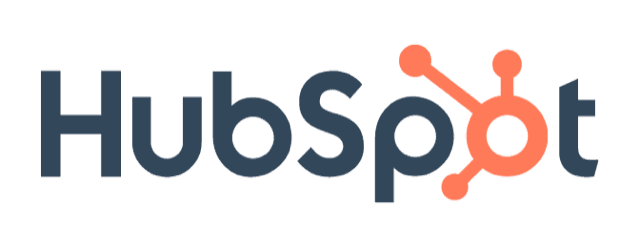Business.com aims to help business owners make informed decisions to support and grow their companies. We research and recommend products and services suitable for various business types, investing thousands of hours each year in this process.
As a business, we need to generate revenue to sustain our content. We have financial relationships with some companies we cover, earning commissions when readers purchase from our partners or share information about their needs. These relationships do not dictate our advice and recommendations. Our editorial team independently evaluates and recommends products and services based on their research and expertise. Learn more about our process and partners here.
HubSpot CRM Review and Pricing

Table of Contents
- HubSpot's shared dashboards offer excellent transparency, giving sales and marketing teams the information they need to cooperate on projects.
- HubSpot's Breeze AI tools are integrated across its entire suite of products to boost productivity, automate tasks and provide in-depth insights.
- HubSpot provides access to content, marketing and e-commerce tools even on its free CRM plan.
- Many powerful features that make HubSpot a great CRM are limited to its most expensive tiers.
- HubSpot's Starter and Professional tiers have significant price gaps, making it difficult for smaller businesses to afford the upgrade.
- You pay extra for past-limit WhatsApp conversations, API calls and more, even on the top service levels.
Many businesses want their sales and marketing teams to work more closely to optimize results. HubSpot CRM is an excellent solution for these companies. Its powerful, easy-to-use, AI-powered reporting and analytics tools provide your staff with the necessary insights to improve lead generation and achieve successful lead conversions. The platform lets colleagues see the latest, most accurate company data on shared dashboards to facilitate discussion, cooperation and collaboration. What really sets HubSpot CRM apart is its cross-functional integration that gives small businesses access to marketing, content and e-commerce tools in a single platform to drive their sales forward.
HubSpot CRM Editor's Rating:
9.5 / 10
- Pricing/value
- 9.2/10
- Features
- 9.6/10
- Customization, add-ons and integrations
- 9.8/10
- Ease of use
- 9.4/10
- Customer service
- 9.5/10
Why We Chose HubSpot for Sales and Marketing Integration
Sales and marketing teams drive revenue and help businesses grow. HubSpot’s tools are uniquely qualified to foster sales and marketing integration, making this customer relationship management (CRM) system an attractive option for many companies.
For example, HubSpot provides shared dashboards and real-time sales and marketing information, which creates a trusted, unified data source that promotes cross-team cooperation and the exchange of insights and opinions. Everyone involved in generating leads and closing sales can use this concrete data to shape the organization’s marketing efforts and sales processes.
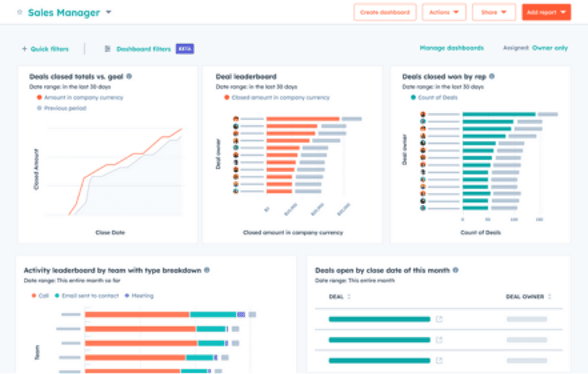
During our evaluation, we loved HubSpot’s AI automation, summarization and content generation functionality. Breeze AI offers automatic conversation, sales interaction and data summaries, builds templates, generates copy and customizes the tone of messages. It also gathers information from across the web and helps populate contact and company details, making it much easier for sales and marketing managers to generate leads and tailor their communication. Per Salesforce research, 51 percent of marketers are using generative AI, highlighting the growing importance of AI capabilities like those found in HubSpot. By making it easy to create, share and access this information, HubSpot accelerates cross-team collaboration and boosts productivity.
According to Nucleaus Research, companies that invest in CRM systems see an “average return of $3.10 per dollar spent,” underscoring the value of platforms like HubSpot in enhancing sales performance. With its automation features like email templates, custom text shortcuts and even a library of documents to share with clients and leads, HubSpot helps increase sales and marketing efforts and allows teams to stay focused. For these reasons and more, HubSpot is our pick for the best CRM for businesses seeking sales and marketing integration.
Ease of Use
We were highly impressed by HubSpot’s usability, especially compared with the more complex competitors we reviewed. Unlike Salesforce and Oracle NetSuite, HubSpot prioritizes intuitive navigation and a visually appealing interface for building complex sales and marketing automations. The same simplicity applies to building workflows for website chats that can be created and managed from within the CRM, providing an extra customer communication and lead generation channel. The vendor wants businesses to get up and running with its software immediately, which aligns with industry trends showing the importance of user-friendly CRM systems for successful adoption.
>> Learn more in our HubSpot vs. Salesforce comparison.
You can use the horizontal menu at the top of the HubSpot screen to access settings and notifications easily, as well as search across your account and the vendor’s support documents and video lessons. Most notably, this menu includes shortcut access to Copilot, HubSpot’s virtual assistant. You can use simple prompts to draft content, pull up specific CRM data quickly, summarize a contact’s activity to prepare for a meeting and more.
We found that accessing various sections, such as automation, reports and tools from other hubs, is straightforward using the vertical menu on the left side of the screen. We like how simple it is to “bookmark” a section you use often for easy access. Higher-tier plans also give managers access to the platform’s Sales Workspace, a daily command center with top-level dashboards, lead and deal details, recommended actions and team activity feeds.
We also enjoyed using the visually pleasing, intuitive interface to create and amend automations and workflows. To add to the system’s functionality, HubSpot’s marketplace contains over 1,800 apps, including integrations with many popular business solutions. HubSpot’s modern user experience is among the best of all the CRMs we evaluated.

HubSpot Features
HubSpot’s CRM features can help foster greater understanding and cooperation between marketing and sales teams. Here are some of the functions we particularly liked:
Shared Dashboards
When we used HubSpot, we appreciated that you can build customized sales dashboards to display individual and team performance metrics, such as win rates and average deal size. The marketing dashboards also reveal engagement performance and conversions overall and by campaign. Updating dashboard elements is simple with a drag-and-drop tool. We found that HubSpot’s attractive, functional dashboards stand out from rival services.
We especially like that teams can share and comment on dashboards, as shared data screens create valuable engagement opportunities. For example, sales representatives can share customer insights with marketing team members by tagging them in a comment. They will be notified instantly and can review what led to the sale or why a marketing campaign failed. Marketers can take these insights and craft more targeted messages to address customer pain points and improve campaigns.

Lead Capturing and Management
HubSpot’s lead-capturing and management tools impressed us. Here are a few highlights:
- Lead scoring and qualification: HubSpot automatically scores leads based on their behavior and profile data, helping sales teams prioritize their efforts.
- Form builder: You can create customizable forms that can be embedded on your website or landing pages to capture lead information.
- Progressive profiling: Use HubSpot to gradually collect more information about leads over time without overwhelming them with lengthy forms.
- Lead nurturing workflows: We were particularly pleased that HubSpot’s flexible CRM software lets you set up various lead-nurturing automations depending on lead scores and other attributes you control.
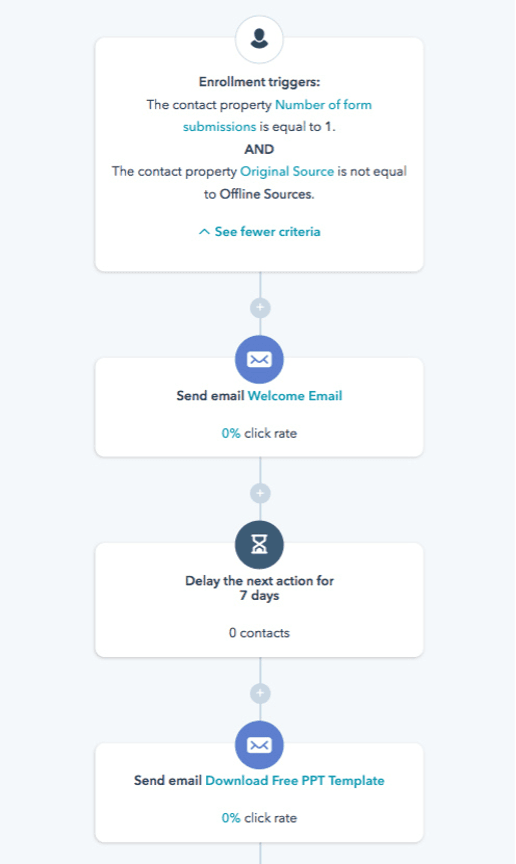
Omnichannel Communication
We love that HubSpot facilitates powerful omnichannel communication, which is ideal for sales and marketing teams. You can interact with and market to customers via phone, text message, live chat, social media and email.
Here are a few aspects of HubSpot’s omnichannel capabilities that impressed us:
- Email marketing integration: Connect your Gmail or Outlook account to send and track emails directly from the CRM. You can design emails using HubSpot’s drag-and-drop tools and optimize them later to improve their performance after you view campaign results.
- Live chat: Engage website visitors in real-time with customizable chat widgets.
- VoIP calling features: Make and receive calls directly from the platform, with call recording and transcription available.
- Social media monitoring: Track mentions and engage with customers across social platforms.
- WhatsApp integration: Communicate with customers through WhatsApp Business API.
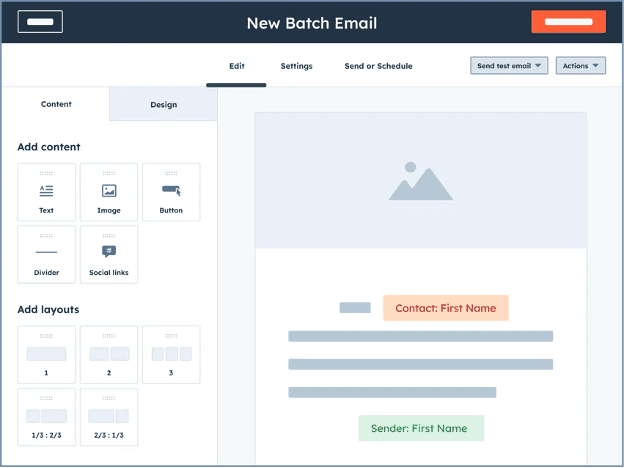
Customer Segmentation
We loved using HubSpot’s powerful customer segmentation tools. You can segment markets using desired attributes like demographics, psychographics and previous interactions, including event attendance. HubSpot lets you create static and active lists — yet another feature that sets it apart from rivals. Static lists include people or companies who meet specific segmentation criteria, while active lists include people or companies added to or removed from the list, depending on their current state.
This feature is helpful for both B2B and B2C companies. For example, a B2B company with a complex sales process could create separate segments based on the company type and sales funnel location, such as “visited the pricing page,” “downloaded the Q4 whitepaper” and “expressed an interest in a demo that has not yet occurred.” Marketers can then use HubSpot’s Breeze AI to create personalized emails for each segment member. After sending the emails, they can create a follow-up calling list for their telemarketing team to reengage past clients or cold leads.

Analytics and Forecasting
We found HubSpot’s data analytics, forecasting and reporting capabilities among the best in the sector for sales leaders and in-house marketing teams — and beyond. Here are a few features we found especially noteworthy:
- Revenue attribution: Track which marketing efforts along the customer journey are driving the most revenue.
- Sales forecasting: Predict future sales performance based on historical data and current pipeline.
- Campaign performance analysis: Measure the ROI of individual marketing campaigns and see whether you’re hitting key performance indicators.
- Sales pipeline analysis: Get insights into deal progression and identify bottlenecks.
- Custom reporting: Create detailed reports tailored to your specific business needs.
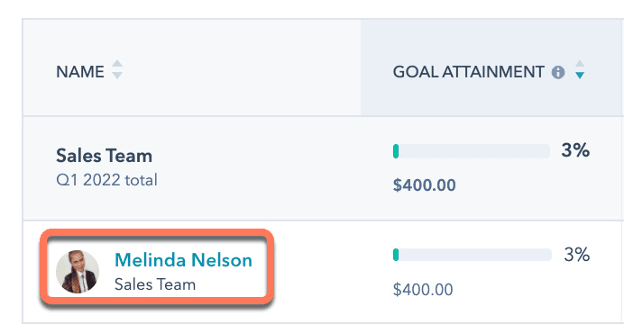
Workflow Automation
HubSpot offers some of the most powerful workflow automation tools of any CRM provider we reviewed. These features help companies optimize sales, marketing and customer service performance. You could, for instance, set up an automation where:
- A prospect downloads a whitepaper from your website.
- HubSpot automatically adds them to a nurturing email sequence.
- After three days, if they haven’t opened the first email, they receive a follow-up email.
- If they do engage, they’re moved to a different workflow based on their interests.
Experimenting with automations helps sales and marketing teams refine their approach. For example, they can determine the ideal interval between contacting leads at various sales funnel stages to significantly enhance the likelihood of securing a sale.
We like how easy it is to build automations in HubSpot using its visual editor or via one of the numerous available templates. We appreciate that this function streamlines workflows and keeps marketing and sales teams aligned throughout the process.
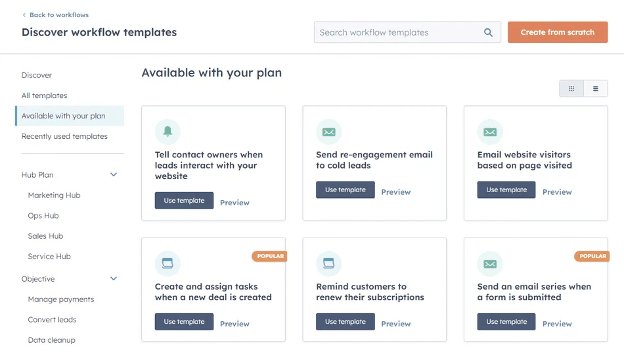
App Marketplace and Integrations
HubSpot’s app marketplace boasts over 1,800 integrations that customers can use to customize the platform. We appreciate how easy it is to find and install the right connections for your company’s needs. For example, you can integrate HubSpot with popular calling apps like Zoom, as well as programs like Twilio, Facebook Messenger and Telegram.
Compared with other CRM marketplaces, we found that HubSpot has a much tighter focus on marketing and sales apps, which is one reason we chose the platform as the best CRM system for sales and marketing team integration.
HubSpot Pricing
HubSpot offers six software products: Marketing, Sales, Customer Service, Content, Operations and Commerce. For simplicity, we’re quoting prices from the Customer Platform, which essentially bundles all of those products into one comprehensive solution.
Free Tools Customer Platform
We love that HubSpot has a free service level — it’s a rarity in today’s marketplace. The features in this tier are limited but still quite generous. This package is available for up to two users and includes up to 1,000 contacts.
Features include:
- Contact and company management
- Deal and task tracking
- Email marketing (up to 2,000 emails per month)
- Limited form creation
- Landing page builder (up to 30 pages)
- Live chat functionality
- Meeting scheduling (one meeting link)
- Basic reporting and analytics
- Limited Copilot AI functionality
However, the free tier lacks crucial functions like social media, automations, one-on-one tech support, custom field mapping, campaign management and employee collaboration tools.
Starter Customer Platform
Price: $9 per seat per month when paid annually; $15 when paid monthly
Features include:
- All of the “Free Tools” CRM features with fewer limits
- Email retargeting and automation
- Ad management for Google and Facebook
- Ability to remove HubSpot branding
- Chat support
- Up to 1,000 marketing contacts
Professional Customer Platform
Price: $1,300 per month for five seats (additional users for $45/month each) when paid annually; $1,450/month (additional users for $50/month each) when paid monthly
Features include:
- All of the “Starter” features
- Predictive lead scoring
- Custom objects and fields
- A/B testing for emails and landing pages
- Custom reporting
- Advanced automation and AI tools
- Phone support
Enterprise Customer Platform
Price: $4,700 per month for seven seats (additional users for $75/month each)
Features include:
- All of the “Professional” features
- Advanced permissions and teams
- Advanced workflow branching
- Predictive forecasting
- Revenue attribution reporting
- Single sign-on (SSO)
- Advanced phone support
Additional Cost Considerations
Although there are no setup or CRM implementation fees with HubSpot, we encourage prospective buyers to consider the following additional costs and options:
- Extra users: Like its peers, Hubspot charges for additional seats.
- Marketing contacts: You’ll pay an additional $50 monthly for every 1,000 records beyond your plan limit.
- API calls: You must pay $500 monthly if you make more than 1 million API calls per day.
- Breeze Intelligence add-on: HubSpot offers AI-powered data enrichment for contact and company records. You can buy one of the packages, containing 100, 1,000 or 10,000 credits per month, with each credit allowing you to fetch information for one record. However, the credits reset each month, don’t roll over, and you will be automatically upgraded to the higher tier package if you exceed your limit. Package prices range between $30 and $700 per month.
- Additional Professional-level charges: When you move up to the Professional tier, dedicated IPs, list limit increases, transactional emails and WhatsApp conversations attract extra charges. This can make it challenging to understand how much you’ll spend upfront.
- Onboarding services: HubSpot offers onboarding packages that cost up to $24,000. The company doesn’t promote this charge, but customers have reported online that onboarding costs can be as little as $750 or run into five figures, depending on the product, tier, number of users and desired configuration.
For its paid subscriptions, HubSpot offers new users a 14-day free trial to determine whether the system is right for their business.
Implementation
Setting up HubSpot CRM involves several phases that will vary depending on your business size and complexity. Understanding potential implementation timelines helps set realistic expectations for your team and ensures a smooth transition to the platform.
Free & Starter Plan Implementation
For small businesses using the Free or Starter plans, initial setup can likely be completed within 1-2 days. This includes:
- Account creation and basic configuration
- Importing existing contact data
- Setting up email integration
- Creating basic forms and landing pages
- Configuring initial workflows
Professional Implementation
Mid-sized businesses implementing the Professional plans typically require 2-4 weeks for full deployment:
- Week 1: Data migration, user setup and basic customization
- Week 2: Advanced workflow configuration and integration setup
- Week 3: Team training and testing
- Week 4: Go-live and optimization
Enterprise Implementation
Large organizations with complex requirements and Enterprise subscribers may need 6-12 weeks:
- Weeks 1-2: Discovery, planning and data architecture
- Weeks 3-6: Custom object creation, advanced automation setup and integration development
- Weeks 7-10: User training, testing and refinement
- Weeks 11-12: Go-live and optimization
Successful adoption requires proper training. We appreciate that HubSpot’s provides in-depth documentation and video tutorials in its knowledge base to facilitate implementation. We found that the platform’s intuitive design helps teams achieve productivity improvements quickly once the software is fully set up and users are trained.
Customer Support
HubSpot offers comprehensive customer support options designed to help users maximize their platform investment. The level of support varies by plan tier, which isn’t uncommon in the CRM sector.
Available across all paid plans, HubSpot’s email and in-app chat support provides timely responses to technical questions and platform guidance. For Professional and Enterprise customers, phone support offers direct access to HubSpot’s technical specialists with 24/7 availability. Both Professional and Enterprise customers receive round-the-clock phone support, ensuring business continuity regardless of time zone or urgency. However, the pricing of these packages will most likely preclude smaller businesses from taking advantage of this customer service.
We appreciated that HubSpot maintains an extensive library of self-help resources accessible to all users. HubSpot Academy offers free courses covering inbound marketing, sales, customer service and platform-specific training. These courses help teams develop both strategic knowledge and technical skills.
There is also a community forum, the HubSpot Community, which connects users with peers and HubSpot experts to share best practices, ask questions and discover innovative use cases. This is valuable for those with the free platform, as they aren’t entitled to email or chat support, as well as Starter subscribers, who can’t receive phone support. The latter is particularly disappointing because, although the Starter package is a good value, we think paying customers of any tier should be able to speak to a customer service rep.
Companies may also like that HubSpot maintains a global network of certified partners who can provide additional implementation, customization and strategic consulting services for a fee. This partner ecosystem extends support capabilities beyond HubSpot’s direct offerings, so it’s particularly valuable for businesses requiring specialized industry expertise or complex customizations.
Limitations
While HubSpot is a full-featured CRM with many upsides, we identified some limitations during our research and testing:
Pricing structure: There’s a significant jump in pricing between the Starter and Professional tiers. This gap can make it challenging for growing small businesses to scale their usage affordably. Furthermore, HubSpot’s per-user pricing is more expensive than that of other providers we evaluated. Although this solution can provide significant value by aligning your sales and marketing teams, it requires a major financial commitment.
Additional costs: Even on the highest-tier plans, you may incur extra charges for exceeding limits on WhatsApp conversations, API calls or additional marketing contacts. You may also encounter unexpected charges with HubSpot if you purchase the Professional package — $3,600 a year for a dedicated IP for your marketing emails and $7,200 a year for transaction emails. That’s more expensive than most specialist business hosting providers or email platforms.
Feature restrictions: Many advanced features that make HubSpot particularly powerful — such as predictive lead scoring, advanced reporting and AI-powered prospecting tools — are only available on the higher-level plans. This limitation means smaller businesses may not be able to access HubSpot’s full potential. While the number of features in the Starter level is good, you need access to the Professional tier to get full functionality and the best value.
Learning curve: While HubSpot is generally user-friendly, some advanced automation and reporting features can be complex to set up and require significant training to use effectively. Also, while HubSpot offers many integrations, some require additional configuration or third-party tools to work seamlessly, which can increase implementation difficulty and costs.
Reporting limitations: While HubSpot’s reporting capabilities are robust, some users find that custom reporting options are limited compared to specialized analytics platforms, particularly for complex data analysis requirements.
Methodology
When evaluating the best CRM software, we pinpointed platforms with the necessary features to enhance sales, marketing and customer support. Our review process included:
- Reaching out to company representatives
- Testing features and functions
- Assessing pricing
- Reviewing company tutorials and support materials
When looking for the best CRM for sales and marketing integration, we focused on each solution’s:
- Contact and deal management
- Sales enablement
- Reporting and analytics
- Workflow and process automation
- Team management features
- E-commerce modules
- Available integrations
Our goal is to help you choose the right software for your unique business so you can succeed with whichever CRM you purchase.
HubSpot FAQs
Bottom Line
We recommend HubSpot CRM for …
- Small to medium-sized businesses seeking an all-in-one sales and marketing solution.
- Companies looking to improve collaboration between sales and marketing departments.
- Organizations that want to start with a free CRM and scale up as they grow.
We don’t recommend HubSpot CRM for …
- Businesses with extremely tight budgets that cannot afford the jump to Professional pricing.
- Companies that only need basic CRM functionality without marketing integration.
- Organizations requiring extensive customization beyond HubSpot’s standard capabilities.
Mark Fairlie contributed to this review.

